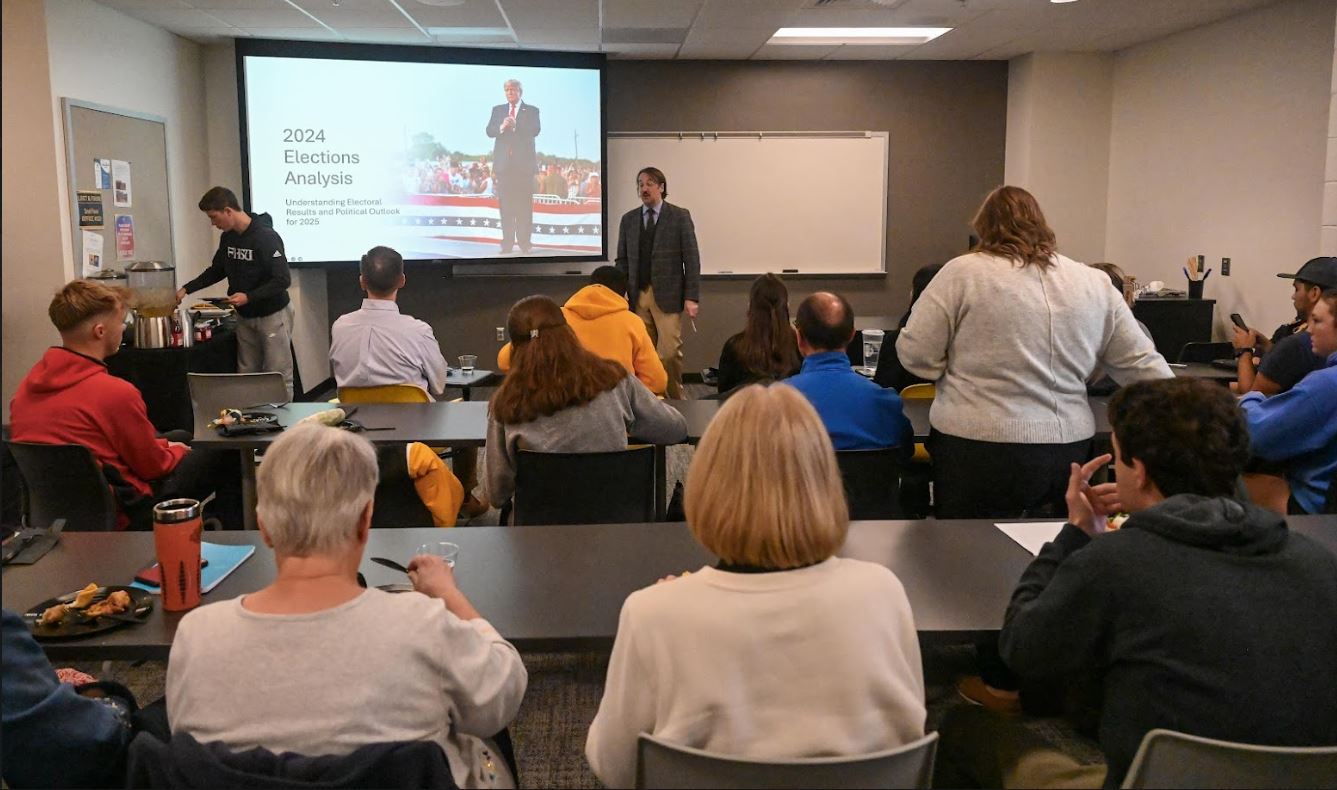By RORY MOORE
Tiger Media Network
The American Democracy Project hosted a Times Talk led by Assistant Professor of Political Science Jay Steinmetz on Thursday to discuss the results of the 2024 Election. Steinmetz analyzed what issues influenced the outcome, which demographics shaped the election based on voting data, and why President-elect Donald Trump decisively defeated sitting Vice President Kamala Haris.
The Republicans are projected to win the Senate, House, and Presidency, which Steinmetz attributed to a more right-leaning electorate demographically and geographically.
“Trump showed noticeable improvement from 2020 among Hispanics, Latino voters, black voters, and younger voters,” he said. “We saw a significant rightward shift across the country in county-by-county data, especially in more liberal areas and big cities. We saw huge shifts toward the Republican Party in cities like Philadelphia, New York City, Milwaukee, Atlanta, and other places.”
He also pointed out the loss of voters for the Democrats among those demographics.
“The takeaway is that Harris significantly underperformed from Joe Biden’s performance in 2020,” Steinmetz said. “A lot of the collapse of Democratic support is in those younger voters, especially black voters in rural areas of America and Hispanic voters in Florida and Texas. That’s where we saw big declines in overall numbers.”
Steinmetz identified various factors that drove voters to the Republicans and away from the Democrats, namely immigration, the economy, the concern over President Biden’s cognitive function and his removal, identity politics, and the anti-establishment rhetoric.
“The border is symbolic or is connected to a whole bunch of other policy concerns that Trump supporters hold,” he said. “The border is connected to our drug crisis, fentanyl overdose crisis, and crime in this country. It’s connected to national security imperatives.”
He linked the former theory to the large decrease in Democratic voters in reliably blue areas after Texas Gov. Greg Abbott and Florida Gov. Ron DeSantis transported migrants from their states to those areas.
“Republican governors sought to bring the politics of the border to non-border areas to highlight the crisis of the border toward areas of this country that are far removed from our southern border,” Steinmetz said. “I think it had a substantial effect in cities like New York City where he had a huge turn toward Trump voters.”
A key figure that Steinmetz presented was how the former and future president attracted many voters who were not conservative or Republican but were first-time or low-propensity voters.
“Newer voters who decided to vote particularly voted just for Trump,” he said. “We saw a lot of folks voting to protect abortion rights in states that had abortion on the ballot but voting for Trump. We saw a lot of voters not vote for Senate candidates or down-ballot Republicans but vote for Trump.”
Steinmetz’s analysis found that Trump won those voters through his populist messaging and factors in their external environment like inflation, crime, and immigration.
“That says something about what he is as a political figure,” Steinmetz determined. “He attracts folks who are outside of the political ecosystem. They’re not paying attention to politics all the time. They’re not always connected to policy and what’s happening. They’re seeing things in life that are compelling them and drawing them toward the Trump movement.”
A common talking point before the elections was the perceived statistical gap in gender, with men increasingly voting Republican and women voting Democrat. Steinmetz showed, however, that the gap neither grew nor narrowed.
“We saw remarkably mirrored movements from both men and women from 2020 to 2024,” he said. “There was a 3% increase in men and women of all age categories for Trump, a 2% decline in women from Biden and Harris, and a slightly more decline in men from Biden and Harris. Younger voters did not come out much for the Democratic Party. There was a 15% increase in men between the ages of 18 and 29 voting for Trump. Women, a 7% increase for Trump in that age category.”
The conclusion Steinmetz came to was that voters were dissatisfied with the work of the current administration and the state of the country.
“They wanted to vote for change and kick out the incumbents,” he said. “A lot of people are tired of this pandemic-era political leadership in which they associate this leadership with chaos, instability, government overreach, inflation, overall discontent, and public melees.”






